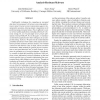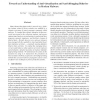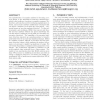IPCCC
2007
IEEE
14 years 6 months ago
2007
IEEE
Rapidly-spreading malicious software is an important threat on today’s computer networks. Most solutions that have been proposed to counter this threat are based on our ability ...
ICC
2007
IEEE
14 years 6 months ago
2007
IEEE
Abstract— Recent outbreaks of virus and worm attacks targeted at cell phones have bought to the forefront the seriousness of the security threat to this increasingly popular mean...
NDSS
2008
IEEE
14 years 6 months ago
2008
IEEE
Traditionally, techniques for computing on encrypted data have been proposed with privacy preserving applications in mind. Several current cryptosystems support a homomorphic oper...
NDSS
2008
IEEE
14 years 6 months ago
2008
IEEE
Malware programs that incorporate trigger-based behavior initiate malicious activities based on conditions satisfied only by specific inputs. State-of-the-art malware analyzers ...
ICDCS
2008
IEEE
14 years 6 months ago
2008
IEEE
The possibility of using purely text stream (keyboardenterable) as carrier of malware is under-researched and often underestimated. A text attack can happen at multiple levels, fr...
DSN
2008
IEEE
14 years 6 months ago
2008
IEEE
An important yet largely uncharted problem in malware defense is how to automate generation of infection signatures for detecting compromised systems, i.e., signatures that charac...
DSN
2008
IEEE
14 years 6 months ago
2008
IEEE
Many threats that plague today’s networks (e.g., phishing, botnets, denial of service attacks) are enabled by a complex ecosystem of attack programs commonly called malware. To ...
RAID
2009
Springer
14 years 7 months ago
2009
Springer
In this paper, we leverage the concepts of formal grammar and genetic operators to evolve malware. As a case study, we take COM infectors and design their formal grammar with produ...
ICARIS
2009
Springer
14 years 7 months ago
2009
Springer
The sophistication of modern computer malware demands run-time malware detection strategies which are not only efficient but also robust to obfuscation and evasion attempts. In thi...
GECCO
2009
Springer
14 years 7 months ago
2009
Springer
The sophistication of computer malware is becoming a serious threat to the information technology infrastructure, which is the backbone of modern e-commerce systems. We, therefore...







